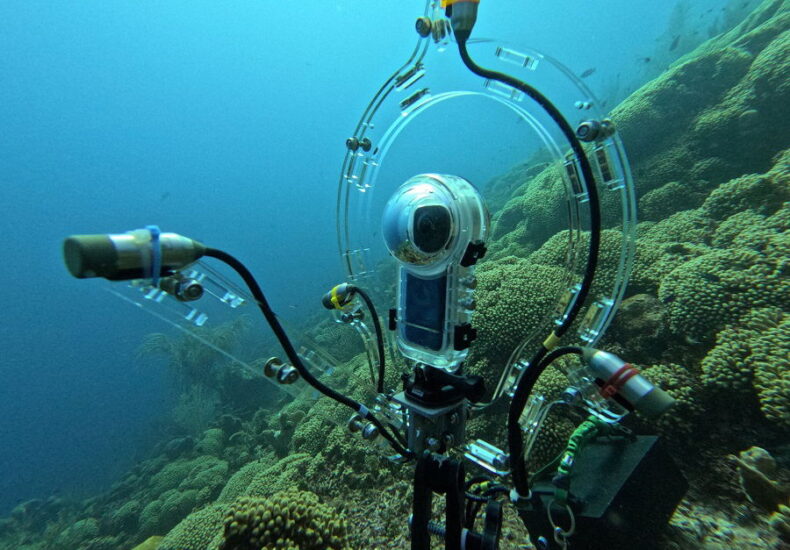
What noise does a fish make? New tool reveals the answer
For decades, ecologists have listened to the underwater world using sound recorders. These devices capture rich soundscapes filled with cracks, snaps, and thumps—most of them produced by marine life. But one big question has remained unanswered: which fish makes which sound?
Now, thanks to a new invention, scientists are starting to decode the hidden voices of coral reefs.
### Introducing the UPAC-360: A Breakthrough in Underwater Acoustic Monitoring
A research team from FishEye Collaborative, Cornell University, and Aalto University has developed a tool that combines underwater sound recording with 360-degree video. The device, called the UPAC-360 (short for omnidirectional underwater passive acoustic camera), can match specific sounds to the fish that produce them.
In their first field test, researchers identified the sounds of 46 different species on Caribbean reefs near Curaçao. Remarkably, more than half of these species were not previously known to make any sound at all.
### Why This Discovery Matters
Sound is one of the most important ways to study coral reefs. Tropical reefs cover less than 0.1 percent of the ocean floor but support roughly a quarter of all marine species. They are among the most diverse ecosystems on Earth, yet they are in steep decline due to climate change, pollution, and overfishing.
With nearly a billion people worldwide relying on reefs for food, jobs, and coastal protection, scientists urgently need better ways to monitor how these fragile ecosystems are changing.
Dr. Marc Dantzker, executive director of FishEye Collaborative and lead author of the study, compares the variety of fish sounds to birdsong in a rainforest.
> “The diversity of fish sounds on a coral reef rivals that of birds in a rainforest. In the Caribbean alone, we estimate that more than 700 fish species produce sounds,” he explained.
> “But until now, very few of those sounds could be linked to specific species, making reef monitoring far less precise than it could be.”
### How the UPAC-360 Works
The UPAC-360 solves this problem by combining hydrophones, or underwater microphones, with a 360-degree video camera. While this technique is often used to make immersive virtual reality films, it had never been applied underwater in this way.
By recording the direction of a sound and matching it with a video of the reef, researchers can now see exactly which fish is making which noise.
> “When we visualize that sound and lay it over the 360° image, the result is a video that can reveal which sound came from which fish,” said Dr. Dantzker.
This breakthrough represents the largest collection of identified fish sounds ever published. All recordings have been made publicly available, and the growing library could soon be used to train artificial intelligence systems to identify fish automatically.
It is a vision similar to Merlin—the popular smartphone app that can identify birds by their songs.
> “We’re a long way from having a Merlin for the oceans, but the sounds are useful for scientists and conservationists right away,” said Dr. Aaron Rice, senior author of the study from Cornell University.
### Advantages for Long-Term Monitoring
One of the biggest advantages of the UPAC-360 system is that it can be left in place for long periods, quietly collecting data without the need for divers or boats. This allows it to capture natural fish behaviors and vocalizations that would otherwise go unnoticed.
> “The fact that our recording system is put out in nature and can record for long periods means we’re able to capture species behaviors and sounds that have never before been witnessed,” Dr. Rice explained.
### Implications for Conservation
The implications of this technology for conservation are significant. By learning which fish make which sounds, scientists can begin to decode reef soundscapes in detail.
This means sound could be used as a powerful new tool to measure reef health, track biodiversity, and evaluate restoration efforts.
> “By identifying which species make which sounds, we’re making it possible to decode reef soundscapes, transforming acoustic monitoring into a powerful tool for ocean conservation,” said Dr. Dantzker.
Matt Duggan, a Ph.D. candidate on the project, highlighted an important challenge that the technology helps overcome:
> “Many of the reef’s voices have long been drowned out by louder species like dolphins, whales, and snapping shrimp. By discovering the identity of these hidden voices, acoustics will become a powerful indicator of reef health and resilience—and a strategy to monitor wider and deeper,” he said.
### Next Steps in Research
The work is just beginning. While the study identified 46 species, that represents only a fraction of the life on a Caribbean reef.
The team is now expanding its efforts, building larger sound libraries for Curaçao and moving on to reefs in Hawaii and Indonesia.
As the catalog grows, ecologists will get closer to answering a question once thought impossible: *What noise does a fish make?*
—
*Stay tuned for more updates on this exciting fusion of technology and marine biology, as scientists continue to unlock the secret sounds of our oceans.*
https://knowridge.com/2025/10/what-noise-does-a-fish-make-new-tool-reveals-the-answer/
You may also like
You may be interested
NASA is now a spy agency, thanks to Trump’s order
NASA Is Now a Spy Agency, Thanks to Trump’s Executive...
NASA is now a spy agency, thanks to Trump’s order
**NASA Is Now a Spy Agency, Thanks to Trump’s Order**...
Public–Private Partnerships: The Future Of Wildlife Protection?
The challenge of wildlife protection in the 21st century is...
 The New York Times
The New York Times
- U.S. Border Patrol Launches Operation in Charlotte, N.C. 2025 年 11 月 16 日 Eduardo Medina and Bernard Mokam
- 4 Dead After Suspected Migrant Boat Overturns Near a San Diego Area Beach 2025 年 11 月 15 日 Mark Walker
- Storm Pounds Southern California With Heavy Rains and Some Flooding 2025 年 11 月 15 日 Amy Graff
- Former Fed Official Violated Trading Rules, Disclosures Show 2025 年 11 月 15 日 Colby Smith
- Fetterman Is Released From the Hospital After a Fall 2025 年 11 月 15 日 Billy Witz
- Alice Wong, Writer and Relentless Advocate for Disability Rights, Dies at 51 2025 年 11 月 15 日 Clay Risen
- Displaced Gazans Face More Misery as Torrential Rain Lashes Enclave 2025 年 11 月 15 日 Bilal Shbair, Abu Bakr Bashir and Aaron Boxerman
- Gallego Pitches Demoralized Democrats on a Midterm Message 2025 年 11 月 15 日 Catie Edmondson
- Once He Was ‘Just Asking Questions.’ Now Tucker Carlson Is the Question. 2025 年 11 月 15 日 Robert Draper
- America’s Formula for Greatness Is Under Threat 2025 年 11 月 15 日 Nicholas Kristof



Leave a Reply